Radical Poetry by Eduardo Ledesma

Author:Eduardo Ledesma
Language: eng
Format: epub
Publisher: State University of New York Press
Published: 2016-03-15T16:00:00+00:00
tren en marcha
tttttttttttttttttrrrrrrrrrrrrrrrrrrrrrrrrrrrrrrrrrrren en marcha
marchchchchchchchchchchchchchchchchchchchchchcha
This apparently “simple” early poem displays all the characteristic elements of Uribe’s later works: a will to motion, as the train “caboose” both insinuates movement and onomatopoeically illustrates it with the repeating “chchchch” sound; a tendency to rely more on letters than full words—as shown by the gradual disintegration of words from the first “verse” to the last two; an interest in the visual shape and materiality of poetry used to emphasize something other than semantic meaning; the integration of the typographical with the mechanical (a train), or in other cases, with the biological. In fact, all three stages in Uribe’s poetry display two dominant characteristics: first, the use of motion and, second, the mecanomorphic or biomorphic, often anthropomorphic, deployment of letters, which Uribe (in a move that courts the animistic) describes as having a secret life.1 Accordingly, she affirms that the letters themselves are a major source of her inspiration, while “the main components are typography and motion” (Sapnar n.p.). Her letter poems are imbued with a mechanistic and animistic vitality, and emphasize a visual language increasingly animated and engaged with the viewers’ senses. Raley’s observation about digital poetry’s most salient aesthetic turn describes Uribe’s work with remarkable exactitude:
The first and most significant turn … [has been] … an embedding of humans and computational media within a larger assemblage comprised of human and nonhuman actors and lively, vibrant, animate matter. The second marks a turn from a mode of composition in which different media elements—such as text, image, video, sound, and algorithm—are contiguous but distinct to a mode of composition in which they are more clearly syncretized. (889)
Other critics have noted the perceived “syncretism” between animate and inanimate, human and nonhuman matter. Poet Jim Andrews has praised the “corporeality” of Uribe’s work and observes that, in her poetry, letters and words have the capacity to “dance with human feeling, with the gestures of the body, with the body of the body” (“Nio and Visual/Sound Poetry” n.p.). In the later phase of Uribe’s poetry the anthropomorphic component is enhanced by the addition of a sparse narrative plot structure, eroding the separation between poetry and narrative and proving that temporality and spatiality are not at odds with each other in the digital medium. The result, I suggest, is that the letters’ potential to engage the viewer’s affect increases dramatically.
“A herd of centaurs” (1998) (Fig. 6.1) is an early digital poem whose significance hinges on understanding how it deploys the anthropomorphic, and its related term, theriomorphic, “literalized” through the trope of the centaur. Theriomorphic is derived from the Greek for either a wild beast, or a bestial man, (therion) and “morph” for shape. The dual definition pointing to man and beast reflects the complexity hidden under the poem’s apparent simplicity. Inherently hybrid, the poem’s key image, the centaur, calls to mind Surrealism and its particular fondness for the juxtapositions of man and machine, or man and beast, as with the Surrealist magazine Minotaure (1933–39). Uribe’s poem simulates the
Download
This site does not store any files on its server. We only index and link to content provided by other sites. Please contact the content providers to delete copyright contents if any and email us, we'll remove relevant links or contents immediately.
4 3 2 1: A Novel by Paul Auster(11094)
The handmaid's tale by Margaret Atwood(6891)
Giovanni's Room by James Baldwin(5921)
Big Magic: Creative Living Beyond Fear by Elizabeth Gilbert(4750)
Asking the Right Questions: A Guide to Critical Thinking by M. Neil Browne & Stuart M. Keeley(4619)
On Writing A Memoir of the Craft by Stephen King(4240)
Ego Is the Enemy by Ryan Holiday(4019)
Ken Follett - World without end by Ken Follett(3990)
The Body: A Guide for Occupants by Bill Bryson(3849)
Bluets by Maggie Nelson(3739)
Adulting by Kelly Williams Brown(3699)
Guilty Pleasures by Laurell K Hamilton(3611)
Eat That Frog! by Brian Tracy(3544)
White Noise - A Novel by Don DeLillo(3451)
The Poetry of Pablo Neruda by Pablo Neruda(3384)
Alive: The Story of the Andes Survivors by Piers Paul Read(3329)
The Book of Joy by Dalai Lama(3252)
The Bookshop by Penelope Fitzgerald(3244)
Fingerprints of the Gods by Graham Hancock(3235)
